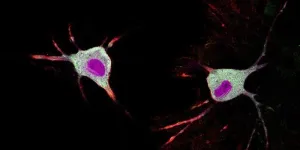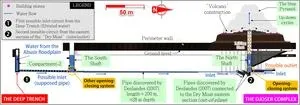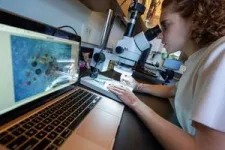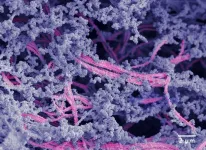(Press-News.org) Researchers at the University of California, Davis have developed a rapid, noninvasive tool to track the neurons and biomolecules activated in the brain by psychedelic drugs. The protein-based tool, which is called Ca2+-activated Split-TurboID, or CaST, is described in research published in Nature Methods.
There has been mounting interest in the value of psychedelic-inspired compounds as treatments for brain disorders including depression, post-traumatic stress disorder and substance use disorder. Psychedelic compounds like LSD, DMT and psilocybin promote the growth and strengthening of neurons and their connections in the brain’s prefrontal cortex. The new tool could help scientists unlock the benefits of psychedelic treatments for patients with brain disorders.
“It’s important to think about the cellular mechanisms that these psychedelics act upon,” said Christina Kim, an assistant professor of neurology at the UC Davis Center for Neuroscience and School of Medicine, and an affiliate of the UC Davis Institute for Psychedelics and Neurotherapeutics. “What are they? Once we know that, we can design different variants that target the same mechanism but with fewer side effects.”
This research provides scientists with a new technique that could be used to track step by step the molecular signaling processes that are responsible for these compounds’ beneficial neuroplastic effects. What’s more, CaST accomplishes the task of cellular tagging in rapid time, taking 10 to 30 minutes rather than the hours typical of other tagging methods.
“We designed these proteins in the lab that can be packaged into DNA and then put into harmless adeno-associated viruses,” Kim said. “Once we deliver the CaST tool and these proteins into neurons, then they incubate inside the cells and start expressing.”
The research was conducted in collaboration with David Olson, founding director of the Institute for Psychedelics and Neurotherapeutics and a professor in the departments of Chemistry and Biochemistry and Molecular Medicine.
A snapshot of the brain
The CaST tool takes advantage of changes in intracellular calcium concentrations, a nearly universal marker to track activity in a neuron. When neurons exhibit high activity, they exhibit high calcium levels. CaST uses this cue to tag the cell with a small biomolecule called biotin.
In the study, Kim and her colleagues dosed mice with the psychedelic psilocybin. They then used CaST in tandem with biotin to identify neurons with increased calcium in the prefrontal cortex. The prefrontal cortex is an area affected by many brain disorders and also an area where psychedelics promote neuronal growth and strengthening.
The researchers also monitoring the head-twitch responses in the mice. Head-twitch responses are the primary behavioral correlate for hallucinations caused by psychedelics.
“What’s nice about CaST is that it can be used in a freely behaving animal,” said Kim, noting that other cellular tagging technologies require stabilizing a mouse’s head to accomplish imaging. “Biotin is also a great tagging substrate because there are many pre-existing commercial tools that can report whether biotin is present or not just by a simple staining and imaging method.”
The proof-of-concept experiment gave what Kim called “a camera snapshot” of the areas in the prefrontal cortex activated by psilocybin.
Next steps
Kim and her colleagues are now working on methods to enable brain-wide cellular labeling with the CaST tool. Additionally, they’re exploring ways to enrich the signature of individual proteins produced by neurons affected by psychedelics.
“We can send those samples to the UC Davis Proteomics Core Facility and they can give us an unbiased picture of all the proteins we identified,” Kim said. “We want to examine their entire contents in terms of what proteins they express, what genes they express, and try to see what’s different in psilocybin-treated animals versus control animals or animal models of diseases.”
The goal is to identify how psychedelics benefit the cellular profiles of those with brain disorders, elucidating the step-by-step cellular process of their therapeutic effects.
Kim expressed interest in conducting future experiments in collaboration with Olson’s lab that use the CaST tool to compare the neuronal activity induced by psychedelics to the activity induced by non-hallucinogenic neurotherapeutics.
“CaST will be an important tool for studying the mechanisms of action of these neurotherapeutic drugs,” Kim said.
Additional UC Davis authors on the study include lead authors Run Zhang and Maribel Anguiano, and Isak K. Aarrestad, Sophia Lin, Joshua Chandra and Sruti S. Vadde.
The work was supported by grants from the Brain and Behavior Research Foundation, Kinship Foundation, Arnold and Mabel Beckman Foundation, NIH, NSF and the Boone Family Foundation.
END
New method tracks how psychedelics affect neurons in minutes
2024-08-05
ELSE PRESS RELEASES FROM THIS DATE:
Record number of drug overdoses in one year reported
2024-08-05
August 4, 2024-- Drug-involved overdose deaths increased by over 500 percent in 2022 according to a study at Columbia University Mailman School of Public Health, with trends attributed to synthetic opioids. National data shows that fentanyl and heroin in particular attributed substantially to the rise particularly since 2014. However, the study also reports that income protection policies, can have a supportive role in preventing fatal drug overdoses. The findings are reported in the International ...
Could this new drug turn back the clock on multiple sclerosis?
2024-08-05
Could This New Drug Turn Back the Clock on Multiple Sclerosis?
Ten years of work, and a little help from the green mamba snake, has resulted in a promising new drug that is already being tested in clinical trials.
Multiple sclerosis (MS) degrades the protective insulation around nerve cells, leaving their axons, which carry electrical impulses, exposed like bare wires. This can cause devastating problems with movement, balance and vision; and without treatment, it can lead to paralysis, loss of independence and a shortened lifespan.
Now, scientists at UC San Francisco and Contineum Therapeutics have developed a drug that spurs the body to replace the lost insulation, ...
Greenland fossil discovery reveals increased risk of sea-level catastrophe
2024-08-05
The story of Greenland keeps getting greener—and scarier.
A new study provides the first direct evidence that the center—not just the edges—of Greenland’s ice sheet melted away in the recent geological past and the now-ice-covered island was then home to a green, tundra landscape.
A team of scientists re-examined a few inches of sediment from the bottom of a two-mile-deep ice core extracted at the very center of Greenland in 1993—and held for 30 years in a Colorado storage facility. They were amazed to discover ...
New biomaterial regrows damaged cartilage in joints
2024-08-05
Northwestern University scientists have developed a new bioactive material that successfully regenerated high-quality cartilage in the knee joints of a large-animal model.
Although it looks like a rubbery goo, the material is actually a complex network of molecular components, which work together to mimic cartilage’s natural environment in the body.
In the new study, the researchers applied the material to damaged cartilage in the animals’ knee joints. Within just six months, the researchers observed evidence of enhanced repair, including ...
Horse miscarriages offer clues to causes of early human pregnancy loss
2024-08-05
ITHACA, N.Y. – A study of horses – which share many important similarities with humans in their chromosomes and pregnancies – revealed that 42% of miscarriages and spontaneous abortions in the first two months of pregnancy were due to complications from an extra set of chromosomes, a condition called triploidy.
“Over that embryonic period [up to eight weeks from conception], triploidy had rarely been reported in mammals outside of women,” said Mandi de Mestre, professor of equine medicine at Cornell University. “The study tells us that over the first six weeks ...
Hydraulic lift technology may have helped build Egypt’s iconic Pyramid of Djoser
2024-08-05
The Pyramid of Djoser, the oldest of Egypt’s iconic pyramids, may have been built with the help of a unique hydraulic lift system, according to a study published August 5, 2024, in the open-access journal PLOS ONE by Xavier Landreau from CEA Paleotechnic Institute, France, and colleagues. The new study suggests that water may have been able to flow into two shafts located inside the pyramid itself, where that water could have been used to help raise and lower a float used to carry the building stones.
The Pyramid of Djoser, also known as the Step Pyramid, is believed ...
Honey added to yogurt supports probiotic cultures for digestive health
2024-08-05
URBANA, Ill. – If you enjoy a bowl of plain yogurt in the morning, adding a spoonful of honey is a delicious way to sweeten your favorite breakfast food. It also supports the probiotic cultures in the popular fermented dairy product, according to two new studies from the University of Illinois Urbana-Champaign.
“We were interested in the culinary pairing of yogurt and honey, which is common in the Mediterranean diet, and how it impacts the gastrointestinal microbiome,” said Hannah Holscher, associate professor in the Department of Food ...
Tradition meets transformation for Maasai women
2024-08-05
Few communities reveal both the challenges and opportunities presented by cultural globalism more than Maasai communities in northern Tanzania. Traditionally pastoralists, the Maasai ethnic group’s social structure is historically patriarchal, with a man’s prestige measured by the size of his family and by the livestock he owns.
The shrinking world has brought change: Urban centers and the promise of jobs are luring young Maasai from communities, and new technologies such as mobile phones are shifting social patterns and structures that ...
Ochsner Health nurses named to the “Great 100 Nurses of Louisiana” 2024 List
2024-08-05
NEW ORLEANS, La. – Ochsner Health proudly announces that 21 Ochsner nurses have been named to the 2024 Great 100 Nurses of Louisiana list by the Great 100 Nurses Foundation. This recognition highlights the contributions and commitment to excellence demonstrated by Ochsner’s nursing staff.
The Great 100 Nurses Foundation was established to honor nurses in Louisiana, North Carolina, Texas and Oklahoma. Each year, the foundation selects 100 nurses throughout Louisiana based on their concern for humanity, ...
Improved chemokine homing enhances CAR T–cell therapy for osteosarcoma
2024-08-05
(MEMPHIS, Tenn. – August 5, 2024) Chimeric antigen receptor (CAR) T–cell immunotherapy re-engineers a patient’s immune cells to target cancer cells. While successful in some types of leukemia, the approach has yet to realize its potential against pediatric solid tumors. Scientists at St. Jude Children’s Research Hospital have identified a way to improve CAR T–cell homing – a T cell’s ability to navigate effectively to a tumor – for osteosarcoma. Improved homing is a necessary step in designing more successful CAR T–cell therapies. The results were published today in Clinical Cancer ...







